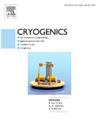t型翅片增强液氮快速冷却过程中的沸腾传热
IF 2.1
3区 工程技术
Q3 PHYSICS, APPLIED
引用次数: 0
摘要
液氮沸腾快速冷却被广泛应用于高温超导(HTS)应用,如电阻型超导故障限流器。然而,薄膜沸腾会降低冷却性能,导致传热系数低。本研究提出了一种低导热系数的t型翅片,以在膜沸腾条件下保留冷却剂并增强沸腾传热。我们研究了t形翅片的高度(0.5、1.0和1.5 mm)对冷却性能的影响。结果表明,最佳加热高度取决于加热表面的温度。在相对低温状态下,翅片高度对冷却性能的影响最小。然而,在更高的温度下,1.0 mm高度的鳍片产生了最高的冷却性能。1.5 mm高度的翅片使产生的蒸汽能够无缝地穿透液体保留空间,降低了传热效率。对于高度最小的0.5 mm的翅片,在加热表面达到一定温度后,冷却性能明显下降,因为蒸汽覆盖了整个翅片表面,表明即使在翅片表面也发生了膜沸腾。另一方面,在导热系数很低的树脂翅片的情况下,在高温条件下的冷却性能高于金属翅片。这表明,即使在高温条件下,翅片表面的沸腾也能得到抑制,并能保持留液效果。为了提高翅片效果和留液效果,我们还提出了两级t型翅片的设计。这种方法旨在保持冷却剂的保留,并抑制高温条件下冷却性能的急剧下降。该研究结果为优化t型翅片设计提供了实用指导,以提高高温超导应用中的冷却性能,减少液氮消耗,并确保在不同温度条件下可靠的热管理。本文章由计算机程序翻译,如有差异,请以英文原文为准。
Enhancement of boiling heat transfer by T-shaped fins during rapid cooling in liquid nitrogen
Rapid cooling via boiling in liquid nitrogen is widely used in high-temperature superconducting (HTS) applications, such as resistive-type superconducting fault current limiters. However, the cooling performance is degraded by film boiling, which results in a low heat transfer coefficient. This study proposes a T-shaped fin with low thermal conductivity to retain the coolant under film-boiling conditions and enhance boiling heat transfer. We examined the effect of the height of T-shaped fins (0.5, 1.0, and 1.5 mm) on cooling performance. The results show that the optimal height depends on the temperature of the heated surface. In the relatively low-temperature regime, the fin height had minimal effect on the cooling performance. However, at higher temperatures a 1.0-mm-height fin yielded the highest cooling performance. The 1.5-mm-height fin enabled the generated vapor to seamlessly penetrate the liquid retention space, reducing heat transfer efficiency. With the 0.5-mm-height fin, which is the smallest height, the cooling performance significantly decreased after a particular temperature of the heated surface, as vapor covers the entire surface of the fin, indicating that film boiling occurs even on the fin surface. On the other hand, in the case of resin fin having quite low thermal conductivity, the cooling performance is higher than that of metal fin under high temperature conditions. This indicates that boiling on the fin surface is suppressed and liquid retention effect can be maintained even in the high temperature regime. To improve both the fin effect and liquid retention effect, we also propose a two-stage T-shaped fin design. This approach aims to maintain coolant retention and suppress the steep decline in cooling performance under high-temperature conditions. The study’s findings offer practical guidance for optimizing T-shaped fin designs to enhance cooling performance in HTS applications, reduce liquid nitrogen consumption, and ensure reliable thermal management under varying temperature conditions.
求助全文
通过发布文献求助,成功后即可免费获取论文全文。
去求助
来源期刊

Cryogenics
物理-热力学
CiteScore
3.80
自引率
9.50%
发文量
0
审稿时长
2.1 months
期刊介绍:
Cryogenics is the world''s leading journal focusing on all aspects of cryoengineering and cryogenics. Papers published in Cryogenics cover a wide variety of subjects in low temperature engineering and research. Among the areas covered are:
- Applications of superconductivity: magnets, electronics, devices
- Superconductors and their properties
- Properties of materials: metals, alloys, composites, polymers, insulations
- New applications of cryogenic technology to processes, devices, machinery
- Refrigeration and liquefaction technology
- Thermodynamics
- Fluid properties and fluid mechanics
- Heat transfer
- Thermometry and measurement science
- Cryogenics in medicine
- Cryoelectronics
 求助内容:
求助内容: 应助结果提醒方式:
应助结果提醒方式:


